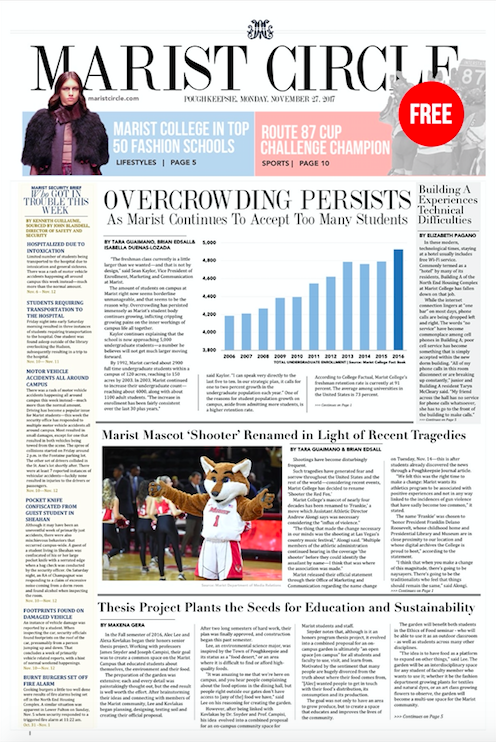Overcrowding Persists As Marist Continues To Accept Too Many Students
By Tara Guaimano, Brian Edsall & Isabella Duenas-Lozada
“The freshman class currently is a little larger than we wanted—and that is not by design,” said Sean Kaylor, Vice President of Enrollment, Marketing and Communication at Marist.
The amount of students on campus at Marist right now seems borderline unmanageable, and that seems to be the reason why. Overcrowding has persisted immensely as Marist’s student body continues growing, inflicting crippling growing pains on the inner workings of campus life all together.
Kaylor continues explaining that the school is now approaching 5,000 undergraduate students—a number he believes will not get much larger moving forward.
“The increase in enrollment has been fairly consistent over the last 30 plus years,” said Kaylor. “I can speak very directly to the last five to ten. In our strategic plan, it calls for one to two percent growth in the undergraduate population each year.”
By 1992, Marist carried about 2900 full time undergraduate students within a campus of 120 acres, reaching to 150 acres by 2003. In 2003, Marist continued to increase their undergraduate count— reaching about 4000, along with about 1100 adult students and over 1000 full and part-time graduate students, as determined by Marist Archives and Special Collections.
One of the reasons for student population growth on campus, aside from admitting more students, is a higher retention rate. According to College Factual, Marist College’s freshman retention rate is currently at 91 percent. The average among universities in the United States is 73 percent.
Kaylor said that although having too many students can cause some issues, having too few students would cause even more.
“If you have fewer students, and you’re not meeting your budget goals, all of a sudden your institution is in a little bit of trouble,” said Kaylor. Having less students ultimately means having less revenue—revenue which helps to pay for programs, construction and other projects at Marist.
Marist’s recent housing issues have heightened the college’s problem of overcrowding. Building D of the North Campus Housing Project was set to be completed in August 2017. However, due to damage of key architectural panels, Building D will not open until the spring 2018 semester.
“We’re never going to accommodate 100 percent of the students,” said Kaylor. “Most schools - even the better one’s - only house 80 to 85 percent of students on campus...if the enrollment ever shrunk, financially speaking, you would not want to have empty beds...With this new housing I believe we’re approaching 80 percent, which is a pretty solid number.”
Despite construction complications, the college has managed to significantly improve housing for students. According to Kaylor, Marist has successfully removed all students from the Marriott Hotel as well as prevent build-ups in freshman dormitories.
Kaylor hopes that Building D’s dining facility will alleviate overcrowding in the main dining hall as well, stating that it will accommodate more than 200 students.
Still, many students feel that parking at Marist College is abysmal—a problem which will not be solved through the completion of the North Campus Housing Project.
“Parking is an issue at every college and university I know, and we’re no different for sure,” said Kaylor.
Building a parking garage has been discussed by the Board of Trustees; however, budgeting has always favored improvements in housing, the creation of academic programs, and more—rather than parking.
Kaylor feels that some parking issues can be solved by the simple will to walk.
“In reality, there probably is additional parking but no one wants those spots because they’re too lazy or they just don’t want to walk that far,” said Kaylor. “I think there is a little bit of a balancing act between having the community understand that maybe we just need to walk a little more and find available parking instead of the one that’s right next to the building.”
Kaylor explained that Marist will definitely have to address parking, but he does not foresee that happening in the near future. “Will it be in the next 10 years? Probably not. Will it be in the next 30? Probably at some point.”
To squash the rumors flying around about Building D’s construction, Director of Housing, Sarah English, explained that the official Marist website includes a section for “Campus Developments” where students can access the progress being made on the new building, which was set to open up in late August. There have been no updates since August 3, 2017.
Students that were supposed to move into the new building this past August were sent an e-mail towards the end of the summer explaining how Fox Run at Fulton, located behind Upper West Cedar, was rented out to accommodate all of the students, and they would be able to move back to campus at the end of the semester.
“The last time I spoke to Fox Run, they told me that the building would be one hundred percent Marist students” Director English said in an interview. The Housing and Residential Department do not have a say in the amount of students that are admitted to the college, but they are involved in the Housing and Enrollment Committee, which meets monthly to discuss plans to accommodate the incoming freshman class.
This year, the college faced minimal build-up rooms that we eventually able to be broken down. This could be caused by Midrise Hall opening up a new floor for freshmen, totaling two floors. There are no current plans to make Midrise an all-freshman dorm.
Director English reiterated that housing is not guaranteed for four years, only the first two years are. After sophomore year, the priority point system will allow residents to select housing based on how many points they have accumulated throughout the year.
From our last print issue.
Find it all around campus.

